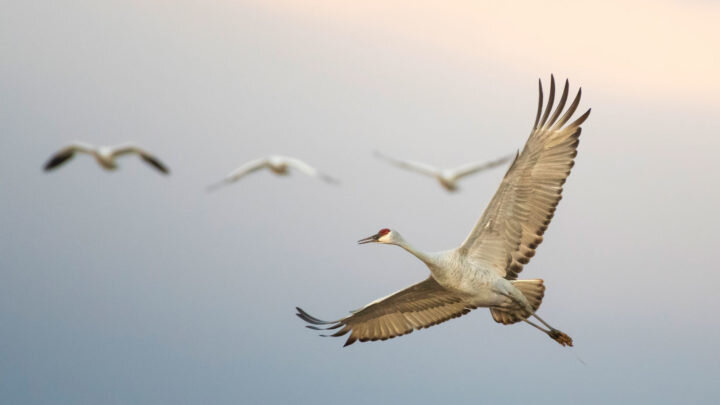The Migratory Bird Treaty Act was first signed into law in 1918 by President Woodrow Wilson in response to the recognition that hundreds of species were at risk of extinction due to the unrestricted commercial and recreational hunting of birds. The law makes it illegal to “pursue, hunt, shoot, wound, kill, trap, capture, or collect, or attempt to pursue, hunt, shoot, wound, kill, trap, capture, or collect” any listed species in absence of a permit. The Migratory Bird Treaty Act has since served as a foundational environmental law that has proved vital to the protection of migratory birds as well as the restoration of declining bird populations. The concern for the state of bird population declines grew to a point where the United States even entered into a treaty with Great Britain on behalf of Canada during World War I to protect the birds migrating between the United States and Canada. Additionally, Mexico, Japan, and Russia have since joined as signatories.
In the decades since it was implemented, the law has successfully protected migratory birds and has even been credited with bringing the snowy egret back from the brink of extinction. The Migratory Bird Treaty Act has also shown to be of particular importance for bird species that are unprotected by other federal laws, such as the Endangered Species Act. At the time of the creation of this law, the main threat to birds was hunting for bird feather hats, however the law remains important as birds today face new threats such as oil spills and urbanization. The U.S. Fish and Wildlife Service, the federal agency in charge of enforcing the Migratory Bird Treaty Act, has noted that over one thousand birds covered by the law have been declining in population due to increasing threats of climate change, collisions with buildings and wind turbines, open oil pits, feral cats, and more. The Migratory Bird Treaty Act has long been recognized to regulate both intentional and unintentional harm to birds. Unintentional harm that may not be intended but is practicable and avoidable, is considered incidental take. An example of this includes the 2010 BP Deep Horizon oil spill where more than a million birds were killed in the four years following the incident. BP was found guilty of violating the law, and subsequently paid $100 million in criminal fines which provided the essential funds needed to restore and clean up the Gulf Coast. This incidental take component of the Migratory Bird Treaty Act has also pushed other industries such as fisheries, oil and gas companies, electrical and wind energy operations, and pesticide applicators to work with the Fish and Wildlife Services in order to develop cost-efficient methods to reduce bird mortality. The Migratory Bird Treaty Act does not have a formal permitting system and instead helps encourage and incentivize industries to follow best management practices, in return for enforcement discretion as only extreme violations of the act have been prosecuted.
However, in December of 2017 the Trump administration suddenly reversed the long-held belief that the Migratory Bird Treaty Act regulated incidental take by industry. The Migratory Bird Treaty Act was reinterpreted to only apply to intentional take such as hunting, which excuses businesses such as oil and gas companies from complying with the law. This change represents a significant shift away from the way the federal government approaches bird conservation and has generated concern amongst conservationists, as large companies will often disregard any impacts on birds. Although industry leaders argue they should not be held responsible for incidental take, there is no denying the impact industries have on bird populations. The Fish and Wildlife Service estimates between 8 and 57.3 million birds die each year from electrical lines and between half and one million die from flying into oil pits. Among the other threats of climate change and habitat loss, this change presents a large challenge for the hundreds of birds protected under the Migratory Bird Treaty Act.

As of May 6th 2021, the Joe Biden administration has announced it would revoke this rule and restore protection seen previous to the Trump administration’s changes. Conservation of migratory birds is an essential part of the mission of the Fish and Wildlife Service. There is hope that the Biden administration will both bring the protections back and strengthen them. Congress now needs to vote on the bill once again, and many hope to see a quick response as well as establishment of a permitting program, however the new proposed ruling has no mention of a permit program to authorize incidental take. It is likely that the Biden administration will finalize the withdrawal of the previous rule, which would restore the interpretation of the rule to prohibit incidental take. However, this previous rule included enforcement “discretion,” and some believe Biden could strengthen and clarify the law by introducing a permit program for incidental take, as was considered by the Obama administration. Although the Trump administration interpretation of the law still remains in effect today, the Fish and Wildlife Service has requested public comments on the proposed revision on or before June 7th, 2021. In the words of Judge Caproni, “It is not only a sin to kill a mockingbird, it is also a crime.”
Sources
Migratory Bird Treaty Act (Defenders of Wildlife)
Trump weakened an iconic law that protects birds. Biden just moved to restore it. (The Washington Post)
Trump guts Migratory Bird Treaty Act in ‘parting gift to the oil and gas industry’ (BirdWatching Daily)
Biden Administration Takes Steps to Reinstate Migratory Bird Protections After Trump Rule Struck Down by Court (Good News Network)
Biden Administration Quick to Dismantle Trump’s Interpretation of the Migratory Bird Treaty Act (North American Windpower)
Victory! Federal Judge Rules Administration’s Bird-Killing Policy is Illegal (Audubon)
Department of the Interior Seeks to Withdraw Migratory Bird Treaty Act Liability Rule (The National Law Review)
What Is the Migratory Bird Treaty Act? (Treehugger)
Image sources: All About Birds, Joel Sartore for National Geographic


